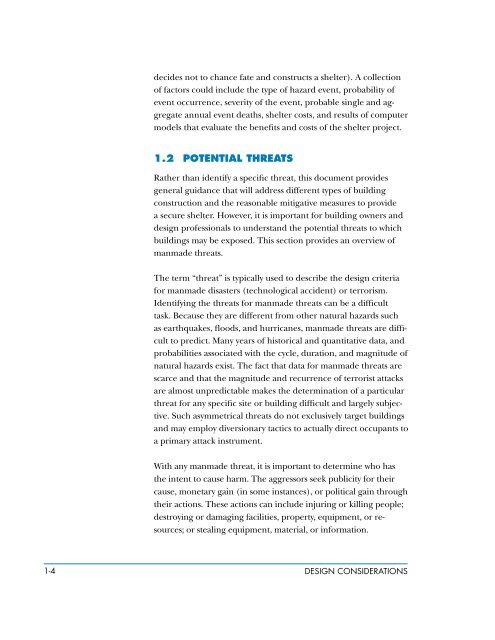FEMA 453 Design Guidance for Shelters and Safe Rooms
FEMA 453 Design Guidance for Shelters and Safe Rooms
FEMA 453 Design Guidance for Shelters and Safe Rooms
Create successful ePaper yourself
Turn your PDF publications into a flip-book with our unique Google optimized e-Paper software.
decides not to chance fate <strong>and</strong> constructs a shelter). A collection<br />
of factors could include the type of hazard event, probability of<br />
event occurrence, severity of the event, probable single <strong>and</strong> aggregate<br />
annual event deaths, shelter costs, <strong>and</strong> results of computer<br />
models that evaluate the benefits <strong>and</strong> costs of the shelter project.<br />
1.2 PotentiaL tHreats<br />
Rather than identify a specific threat, this document provides<br />
general guidance that will address different types of building<br />
construction <strong>and</strong> the reasonable mitigative measures to provide<br />
a secure shelter. However, it is important <strong>for</strong> building owners <strong>and</strong><br />
design professionals to underst<strong>and</strong> the potential threats to which<br />
buildings may be exposed. This section provides an overview of<br />
manmade threats.<br />
The term “threat” is typically used to describe the design criteria<br />
<strong>for</strong> manmade disasters (technological accident) or terrorism.<br />
Identifying the threats <strong>for</strong> manmade threats can be a difficult<br />
task. Because they are different from other natural hazards such<br />
as earthquakes, floods, <strong>and</strong> hurricanes, manmade threats are difficult<br />
to predict. Many years of historical <strong>and</strong> quantitative data, <strong>and</strong><br />
probabilities associated with the cycle, duration, <strong>and</strong> magnitude of<br />
natural hazards exist. The fact that data <strong>for</strong> manmade threats are<br />
scarce <strong>and</strong> that the magnitude <strong>and</strong> recurrence of terrorist attacks<br />
are almost unpredictable makes the determination of a particular<br />
threat <strong>for</strong> any specific site or building difficult <strong>and</strong> largely subjective.<br />
Such asymmetrical threats do not exclusively target buildings<br />
<strong>and</strong> may employ diversionary tactics to actually direct occupants to<br />
a primary attack instrument.<br />
With any manmade threat, it is important to determine who has<br />
the intent to cause harm. The aggressors seek publicity <strong>for</strong> their<br />
cause, monetary gain (in some instances), or political gain through<br />
their actions. These actions can include injuring or killing people;<br />
destroying or damaging facilities, property, equipment, or resources;<br />
or stealing equipment, material, or in<strong>for</strong>mation.<br />
1-4 design considerations

















